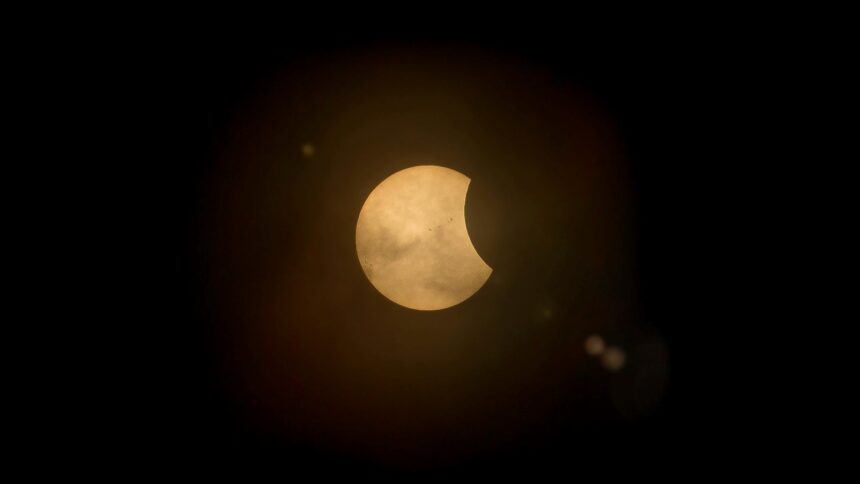On Monday, April 8, a remarkable celestial event will take place – a total solar eclipse that will cast a diagonal swath of North America in temporary darkness. While this phenomenon has been widely discussed, the excitement surrounding it remains palpable.
Here in Florida, we’ll witness a partial eclipse, which is still an awe-inspiring spectacle. Although we won’t experience the complete obscuration of the sun that will plunge cities from Texas to Maine into darkness, for a brief period on Monday afternoon, the sun will be partially obscured, ranging from 44% coverage in the Keys to a substantial 77% in the western Panhandle (with the potential for some cloud interference).
The eclipse will last approximately 2½ hours in Florida. Here’s what we can expect to witness and when:
First Contact: When Does the Eclipse Begin in Florida?
When the eclipse commences, it may go almost unnoticed. The moon’s shadow will start to gradually cover the sun, but it will take some time before the effect becomes evident. The start time of the eclipse will vary for Floridians depending on their location within the state. Those in the western Panhandle, closest to the path of totality, will be the first to see it, scheduled to begin at 12:37 CDT (1:37 EDT).
From there, it will sweep across the state in a diagonal line. The West Coast up through Tallahassee will start to see it five or six minutes later, around 1:43 EDT. Orlando will follow suit five minutes after that, with the east coast quickly joining in.
You can find the eclipse times for your specific ZIP code on the interactive map provided.
It’s crucial to wear eclipse glasses or use protective lenses over your phone, camera, binoculars, or telescope. While you can view an eclipse unprotected during the few minutes of totality when the moon completely blocks the sun, this won’t be the case in Florida. Failing to take proper precautions risks serious, potentially permanent damage to your eyes and eyesight.
Whoa, Halfway There
For the next hour and 20 minutes or so, the moon’s shadow will continue to obscure the sun. The ¼ point, signifying halfway to maximum coverage, will occur 40 minutes into the eclipse at 1:17 CDT (2:17 EDT) in the western Panhandle. At this point, you should be able to discern a distinct crescent shape cut out of the sun.
Once you reach this halfway-to-maximum point, you can create pinhole projections. Hold up anything with a round hole – a homemade pinhole projector, a colander, a piece of cardboard with a hole, a slotted spoon, or even a cracker – and you’ll be able to see an image of the eclipse projected on the ground or any surface beneath it.
If you’re near trees, you’ll also notice cool little crescent eclipse shadows on the ground, created by the leaves acting as natural pinhole projectors.
Additionally, with the sun approaching its “solar maximum” during its 11-year solar cycle, when magnetic activity is at its strongest, you may be able to spot sunspots on the surface using your eclipse glasses.
Maximum Coverage: How Dark Does It Get in a Partial Eclipse?
At around 1:56 CDT (2:56 EDT), the eclipse will reach maximum coverage in the western Panhandle, obscuring up to ¾ of the sun’s surface. About half of the sun will be gone in Orlando (3:03 p.m. EDT), and just under half will be blocked in Key Largo (3:00 p.m. EDT).
However, don’t expect the day to turn into night. A total eclipse dramatically transforms the world around you, but a partial solar eclipse, while still amazing and fun to witness, will create a level of darkness akin to shade on a sunny day.
Temperatures can drop from 10 to 25 degrees during a total solar eclipse, depending on the location. In Florida, we might experience a drop of a few degrees, similar to twilight. NASA welcomes your help in measuring this temperature change.
If enough of the sun is covered in your area, you might be able to spot Venus, which will be the brightest object in the sky besides the sun, about 15 degrees down and to the right. Six of the planets in our solar system will be visible during the eclipse.
Additionally, the “devil comet” (officially known as 12P/Pons-Brooks, named after a horn-like outburst of gas in 2023) will be closest to the sun about two weeks after the eclipse. Look about 30 degrees northeast of the sun, and you might see Jupiter. The comet will be approximately 6 degrees west of that.
During a total eclipse, animals often exhibit unusual behavior, but even during a partial one, you may notice changes as they react to what appears to be an early dusk, according to the Planetary Society. Birds may stop singing and return to their nests, bees may cease foraging, and crickets may begin to chirp. NASA encourages you to report any such observations.
Don’t forget to take pictures, but be sure to use lens filters for your phone or camera. Consider capturing the eclipse in the background of other subjects, such as landmarks or people.
Eclipse Ends, You May Return to Your Regularly Scheduled Earth
After maximum coverage, the moon’s shadow will start shrinking, and around an hour and 18 minutes later, it’ll be over. By 3:14 CDT (4:14 EDT) in the western Panhandle, 4:17 EDT in Orlando, or 4:18 EDT in Daytona Beach, the eclipse will have concluded.
Post your photos, share your experience with friends, indulge in eclipse-themed movies and food deals, and marvel at the astounding pictures from across the country. But don’t forget to mark your calendars for August 2045, when almost the entire state of Florida will be in the path of totality for that year’s eclipse.</p

Leave a Reply
You must be logged in to post a comment.